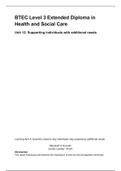BTEC Level 3 Extended Diploma in
Health and Social Care
Unit 12: Supporting individuals with additional needs
Learning Aim A: Examine reasons why individuals may experience additional needs
Maariyah A Hussain
Centre number: 41291
Introduction
This report introduces and explores the importance of why we should diagnose individuals
, with additional needs. It explains the importance, different outcomes and assesses
requirements of different individuals, an adult and a child. It evaluates the significance of
receiving a diagnosis of additional needs to the individuals as well as their families and wider
society.
Learning difficulties are defined as significant, lifelong conditions that begin during teenage/
middle years, affecting development and leading to help being required to process and
understand information, discover new skills and coping independently (1). A mild learning
disability would be one that allows an individual to talk, although they may not understand or
explain new information easily. They may require more time to understand more complex
ideas. A moderate learning disability would mean that an individual finds daily activities such
as dressing or washing more complicated. They may only possess basic language skills and
find it difficult to explain how they may feel and think. severe/profound learning disabilities,
however, are very basic language skills. It may be that individuals use gestures rather than
words. It requires a high level of support, sometimes 24-hour care and attention, and usually
occurs with an individual having more than one learning disability.
P1 - Explain diagnostic procedures to determine additional needs for one child and
one adult with different additional needs
Rebecca Brown - Child case study
Rebecca Brown is an 8-year-old with physical disabilities - she has no movement below her
cervical spine and requires a wheelchair and a personal carer. She lives with her parents
and older brother in an area that isn’t very accommodating to her disability. What Rebecca
has is known as paraplegia. This is a physical disability resulting in spinal cord damage,
causing paralysis from the waist downwards, to both legs.
Paraplegia is a type of paralysis, which is displayed from the waist down. It may be the result
of problems with the brain/spinal cord, that means that all signals to and from the lower body
cannot be sent, it is ultimately the loss of sensation in both legs. Paraplegics may not only
struggle with movement below the waist but also a feeling of tingling, reduced feeling or the
complete inability to feel anything below the waist (2).
Paraplegia is firstly diagnosed by looking at the cause. Any implications resulting in
paraplegia means that the brain/spinal cord has been damaged. A doctor will test an
individual’s motor skills, the sensitivity of the body and reflexes. They might rule out any
other neurological issues. As well as physically examining an individual, they may undergo
certain standards, such as scans or imaging procedures. These procedures, such as X-rays,
CT scans, imaging of the spinal cord, would provide information on the damage and allow a
doctor to make the decision whether an operation/surgery is needed or not (3). Some other
tests include blood tests; to look at any other problems that may be the issue/may be an
issue contributing to paraplegia, such as infections or cancer; a lumbar puncture, to remove
fluid from the spinal cord to be looked at in order to assess function, or Myelography X-rays,
a kind of X-ray that looks at the brain and spinal cord, analysing the function and structure.
This allows doctors to look at possible implications and rule any other issues out (4).
Causes
Any causes of paraplegia are those that affect/cause trauma to the nerves and neurological





